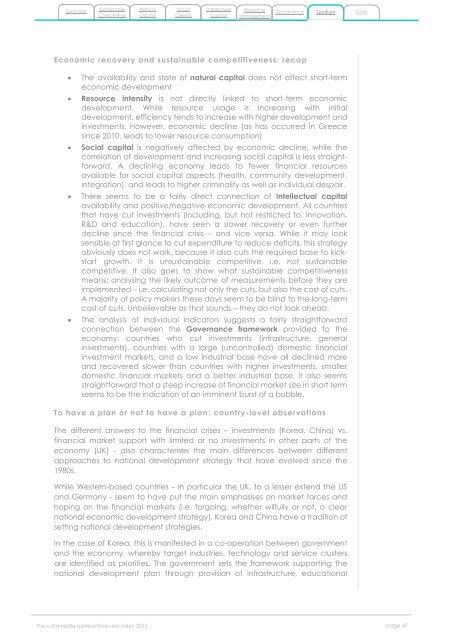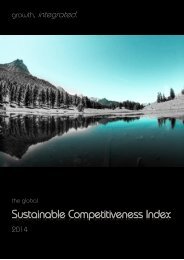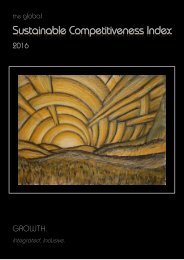The-Global-Sustainable-Competitiveness-Index-2015
You also want an ePaper? Increase the reach of your titles
YUMPU automatically turns print PDFs into web optimized ePapers that Google loves.
Summary<br />
<strong>Sustainable</strong><br />
Competitive<br />
Natural<br />
Capital<br />
Social<br />
Capital<br />
Intellectual<br />
Capital<br />
Resource<br />
Management<br />
Governance Spotlight Data<br />
Social<br />
Capaital<br />
Economic recovery and sustainable competitiveness: recap<br />
<br />
<br />
<br />
<br />
<br />
<strong>The</strong> availability and state of natural capital does not affect short-term<br />
economic development<br />
Resource intensity is not directly linked to short-term economic<br />
development. While resource usage is increasing with initial<br />
development, efficiency tends to increase with higher development and<br />
investments. However, economic decline (as has occurred in Greece<br />
since 2010, leads to lower resource consumption)<br />
Social capital is negatively affected by economic decline, while the<br />
correlation of development and increasing social capital is less straightforward.<br />
A declining economy leads to fewer financial resources<br />
available for social capital aspects (health, community development,<br />
integration), and leads to higher criminality as well as individual despair.<br />
<strong>The</strong>re seems to be a fairly direct connection of Intellectual capital<br />
availability and positive/negative economic development. All countries<br />
that have cut investments (including, but not restricted to, innovation,<br />
R&D and education), have seen a slower recovery or even further<br />
decline since the financial crisis – and vice versa. While it may look<br />
sensible at first glance to cut expenditure to reduce deficits, this strategy<br />
obviously does not work, because it also cuts the required base to kickstart<br />
growth. It is unsustainable competitive, i.e. not sustainable<br />
competitive. It also goes to show what sustainable competitiveness<br />
means: analysing the likely outcome of measurements before they are<br />
implemented – i.e. calculating not only the cuts, but also the cost of cuts.<br />
A majority of policy makers these days seem to be blind to the long-term<br />
cost of cuts. Unbelievable as that sounds – they do not look ahead.<br />
<strong>The</strong> analysis of individual indicators suggests a fairly straightforward<br />
connection between the Governance framework provided to the<br />
economy: countries who cut investments (infrastructure, general<br />
investments), countries with a large (uncontrolled) domestic financial<br />
investment markets, and a low industrial base have all declined more<br />
and recovered slower than countries with higher investments, smaller<br />
domestic financial markets and a better industrial base. It also seems<br />
straightforward that a steep increase of financial market size in short term<br />
seems to be the indication of an imminent burst of a bubble.<br />
To have a plan or not to have a plan: country-level observations<br />
<strong>The</strong> different answers to the financial crises – investments (Korea, China) vs.<br />
financial market support with limited or no investments in other parts of the<br />
economy (UK) - also characterises the main differences between different<br />
approaches to national development strategy that have evolved since the<br />
1980s.<br />
While Western-based countries – in particular the UK, to a lesser extend the US<br />
and Germany - seem to have put the main emphasises on market forces and<br />
hoping on the financial markets (i.e. forgoing, whether wilfully or not, a clear<br />
national economic development strategy), Korea and China have a tradition of<br />
setting national development strategies.<br />
In the case of Korea, this is manifested in a co-operation between government<br />
and the economy, whereby target industries, technology and service clusters<br />
are identified as priorities. <strong>The</strong> government sets the framework supporting the<br />
national development plan through provision of infrastructure, educational<br />
the sustainable competitiveness index <strong>2015</strong><br />
page 47








